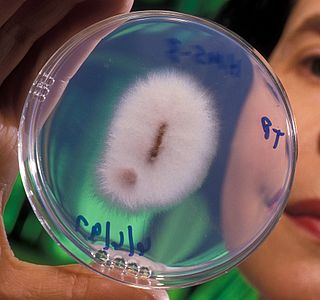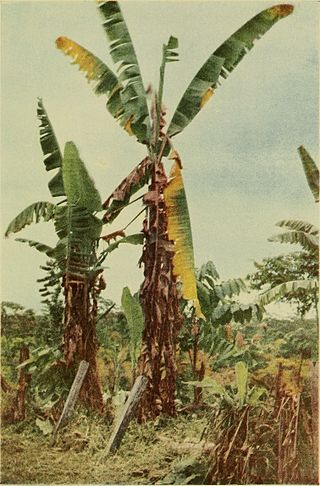Related Research Articles

Fusarium ear blight (FEB), is a fungal disease of cereals, including wheat, barley, oats, rye and triticale. FEB is caused by a range of Fusarium fungi, which infects the heads of the crop, reducing grain yield. The disease is often associated with contamination by mycotoxins produced by the fungi already when the crop is growing in the field. The disease can cause severe economic losses as mycotoxin-contaminated grain cannot be sold for food or feed.

Fusarium oxysporum, an ascomycete fungus, comprises all the species, varieties and forms recognized by Wollenweber and Reinking within an infrageneric grouping called section Elegans. It is part of the family Nectriaceae.

Fusarium wilt is a common vascular wilt fungal disease, exhibiting symptoms similar to Verticillium wilt. This disease has been investigated extensively since the early years of this century. The pathogen that causes Fusarium wilt is Fusarium oxysporum. The species is further divided into formae speciales based on host plant.

Panama disease is a plant disease that infects banana plants. It is a wilting disease caused by the fungus Fusarium oxysporum f. sp. cubense (Foc). The pathogen is resistant to fungicides and its control is limited to phytosanitary measures.

Fusarium is a large genus of filamentous fungi, part of a group often referred to as hyphomycetes, widely distributed in soil and associated with plants. Most species are harmless saprobes, and are relatively abundant members of the soil microbial community. Some species produce mycotoxins in cereal crops that can affect human and animal health if they enter the food chain. The main toxins produced by these Fusarium species are fumonisins and trichothecenes. Despite most species apparently being harmless, some Fusarium species and subspecific groups are among the most important fungal pathogens of plants and animals.

Nufar basil is the first variety of sweet basil that is resistant to fusarium wilt. Fusarium wilt is a disease that causes sudden wilting and death in multiple species, including basil. It is caused by the fungus Fusarium oxysporum f. sp. basilicum, which attacks the xylem in the stem, blocking water uptake and leading to a characteristic sudden leaf wilt that does not respond to watering. Nufar basil is resistant to fusarium wilt, remaining asymptomatic even when infected. It was released in 1999 in Israel by the breeders of the Agricultural Research Organization, and commercialized by Genesis Seeds.

Fusarium oxysporum f.sp. albedinis is a fungal plant pathogen that causes a disease known as Bayoud disease or fusarium wilt primarily on date palm.

Fusarium oxysporum f.sp. ciceris is a fungal plant pathogen that causes fusarium wilt of chickpea.
Fusarium redolens is a species of fungus in the genus Fusarium and family Nectriaceae. This species is a soil-borne plant pathogen in temperate prairies. It causes diseases such as root, crown, and spear rot, seedling damping-off, and wilting disease. It is a known producer of the alkaloids peimisine and imperialine-3β-d-glucoside, which has implications for traditional Chinese medicine.
Fusarium tricinctum is a fungal and plant pathogen of various plant diseases worldwide, especially in temperate regions. It is found on many crops in the world including malt barley, and cereals.

Phytophthora alni is an oomycete plant pathogen that causes lethal root and collar rot in alders. It is widespread across Europe and has recently been found in North America. This species is believed to have originated relatively recently.

Fusarium oxysporum f. sp. cubense is a fungal plant pathogen that causes Panama disease of banana, also known as fusarium wilt of banana. The fungi and the related disease are responsible for widespread pressure on banana growing regions, destroying the economic viability of several commercially important banana varieties.

Fusarium mangiferae is a fungal plant pathogen that infects mango trees. Its aerial mycelium is white and floccose. Conidiophores on aerial mycelium originating erect and prostrate from substrate; they are sympodially branched bearing mono and polyphialides. Polyphialides have 2–5 conidiogenous openings. Phialides on the aerial conidiophores mono- and polyphialidic. Sterile hyphae are absent. Microconidia are variable in shape, obovoid conidia are the most abundant type, oval to allantoid conidia occurring occasionally. Microconidia mostly 0-septate with 1-septate conidia occurring less abundantly. Sporodochia are present. Macroconidia are long and slender, usually 3–5 septate. Chlamydospores are absent.
Streptomyces puniciscabiei is a streptomycete bacterium species known to cause potato common scab disease in Korea. Its type strain is S77T. It has purple-red, spiny spores that are borne in simple rectus flexuous spore-chains.
Streptomyces niveiscabiei is a streptomycete bacterium species known to cause potato common scab disease in Korea. Its type strain is S78T. It has white, smooth, cylindrical spores that are borne in simple rectus flexuous spore-chains.
Plant pathology has developed from antiquity, but scientific study began in the Early modern period and developed in the 19th century.

Koa wilt is a relatively new disease to Hawaii, discovered in 1980. Koa wilt is caused by a forma specialis of the fungus Fusarium oxysporum, which is now abundant in Hawaiian soils and infects the native Acacia koa tree, a once-dominant species in the canopy of Hawaiian forests. Fusarium oxysporum f.sp. koae is believed to have been brought into Hawaii on an ornamental acacia plant. Fusarium fungi clog the tree xylem, causing significant wilt and mortality among these beautiful and iconic Hawaiian trees.
Streptomyces rochei is a bacterium species from the genus of Streptomyces which has been isolated from soil in Russia. Streptomyces rochei produces borrelidin, butyrolactol A, butyrolactol B, uricase and streptothricin. Streptomyces rochei has antifungal activity against Fusarium oxysporum f.sp. lycopersici and Aspergillus fumigatus. Streptomyces rochei produces moenomycin and bambermycin. Streptomyces rochei produces amicetin A, amicetin B, amicetin C and streptolin. Streptomyces rochei produces endo-β-N-acetylglucosaminidase mithramycin, amicetin, bamicetin, and plicacetin.
Vascular wilt in the perennial shrub lulo or naranjilla is a disease caused by the fungus Fusarium oxysporum f. sp. quitoense.
John Colhoun was a British mycologist, phytopathologist, and professor of cryptogamic botany. For a one-year term from 1963 to 1964 he was the president of the British Mycological Society.
References
- 1 2 Zaid, A.; de Wet, P. F.; Djerbi, M.; Oihabi, A. (2002). "Diseases And Pests Of Date Palm". In Zaid, Abdelouahhab (ed.). Date Palm Cultivation. FAO. pp. 227–82. ISBN 978-92-5-104863-4.
- ↑ El Hassni, Majida; El Hadrami, Abdelbasset; Daayf, Fouad; Chérif, Mohamed; Barka, Essaid Ait; El Hadrami, Ismaïl (2007). "Biological control of bayoud disease in date palm: Selection of microorganisms inhibiting the causal agent and inducing defense reactions". Environmental and Experimental Botany. 59 (2): 224–34. doi:10.1016/j.envexpbot.2005.12.008.
- ↑ Bougaada, Toufik (December 28, 2011). "Scientists find desert cure for date disease". SciDev.Net.
- ↑ Dihazi, Abdelhi; Jaiti, Fatima; Wafataktak; Kilani-Feki, Olfa; Jaoua, Samir; Driouich, Azeddine; Baaziz, Mohamed; Daayf, Fouad; Serghini, Mohammed Amine (2012). "Use of two bacteria for biological control of bayoud disease caused by Fusarium oxysporum in date palm (Phoenix dactylifera L) seedlings". Plant Physiology and Biochemistry. 55: 7–15. doi:10.1016/j.plaphy.2012.03.003. PMID 22480991.
- ↑ El Hassni, M.; j'Aiti, F.; Dihazi, A.; Ait Barka, E.; Daayf, F.; El Hadrami, I. (2004). "Enhancement of Defence Responses against Bayoud Disease by Treatment of Date Palm Seedlings with an Hypoaggressive Fusarium oxysporum Isolate". Journal of Phytopathology. 152 (3): 182–9. doi:10.1111/j.1439-0434.2004.00824.x.